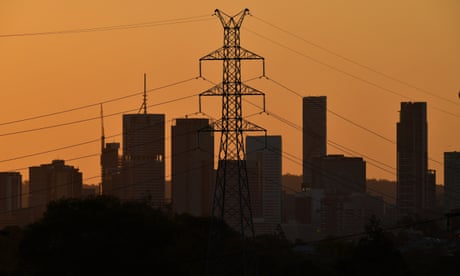- by foxnews
- 23 May 2025
What Australia’s power grid urgently needs for ‘once-in-a-century transformation’ away from fossil fuels
What Australia’s power grid urgently needs for ‘once-in-a-century transformation’ away from fossil fuels
- by theguardian
- 30 Jun 2022
- in news

Work must begin urgently on five big transmission projects if Australia's main power grid is to succeed in its "once-in-a-century transformation" off fossil fuels without shortages and energy cost blowouts, the market operator said in its blueprint report.
The Integrated System Plan (ISP), updated biennially by the Australian Energy Market Operator (Aemo) and released on Thursday, estimated the grid serving eastern states would need at least 10,000km of new transmission lines to link up a nine-fold expansion of wind and solar farm capacity by 2050 under its mostly likely scenario.
By mid-century, almost two-thirds of Australia's detached homes will have their own solar panels, up from about 30% now. To support the rapid expansion of energy sources that vary according to the sunshine and wind, the grid will also need to triple the amount of firming capacity, such as pumped hydro or gas plants.
"Australia is experiencing a complex, rapid and irreversible energy transformation," Aemo's chief executive, Daniel Westerman, said.
"The most economic and reliable source of power for Australian homes and businesses is firmed renewables connected with efficiently delivered transmission."
Without these, the prospect of "reliable, affordable and secure energy to all Australians" will diminish, he said.
The federal climate change and energy minister, Chris Bowen, has talked up the role of the ISP in laying the foundation for the Albanese government's plan to accelerate the transformation of the power grid. Not only can generators reduce their own greenhouse gas emissions, they can enable transport and industry to exit fossil fuels.
"I look forward to working with my fellow energy ministers to modernise the grid, implement the ISP and provide the country with more renewables, more transmission and more storage," Bowen told the National Press Club on Wednesday.
The ISP offers four main scenarios on the pathway to reach net zero emissions by 2050. The most likely scenario, called the Step Change, projects all coal-fired power plants to exit the market by 2043.
It forecasts the grid will lose 14GW of coal plants by 2023, or more than half the 23GW still in the national electricity market. The report said that "coal plant owners have yet announced only 8.4GW in withdrawals", implying that further withdrawals amounting to double the size of Australia's biggest plant - Origin's Eraring - are still to be announced.
The role of gas-fired power plants is more ambiguous. While the market will still need about 10GW of such plants by 2050 - down from about 11GW now - it is less clear how much they will be needed as batteries and other storage comes online. The availability of biomass (for biofuel) or hydrogen could also cut the need for fossil gas fields.
"We are seeing through the investments that are being made, such as [EnergyAustralia's] Tallawarra B and [Snowy Hydro's] Kurri Kurri, plants are being made hydrogen-ready," Westerman said. "That just points to the future proofing of individual investments" with individual investors looking to make them "as carbon neutral as possible".
The ISP's emphasis on the development of big transmission lines reflects the need to have grid connections in the right places and in time to accommodate the required large expansion of wind and solar farms. Overall power demand will double from present levels to 320TWh a year by 2050, while Australia becoming a hydrogen exporting "superpower" would quadruple it.
The key transmission projects will cost $12.7bn but deliver more than double that ($28bn) in "net market benefits", the ISP said.
For the optimal development path, five projects were identified as "immediately actionable": HumeLink, VNI West, Marinus Link, Sydney Ring and New England REZ Transmission Link.
HumeLink, important for connecting the multi-billion dollar Snowy 2.0 pumped hydro scheme is earmarked as necessary by July 2026.
"The value of the [$3.3bn] project is in mitigating the risk that not enough dispatchable capacity is available if there are early coal closures in the period 2026 to 2028," the report said. "That risk may be realised if a third New South Wales coal-fired power station (including Liddell) retires, and two of those four closures have already been announced as likely to occur by 2025."
Bowen on Wednesday confirmed media reports that Snowy 2.0 could be delayed 18 months behind the end-2026 completion date. Snowy Hydro, the project's commonwealth-owned developer, is yet to formally update Aemo, but is expected declare the delay within months.
Notable in the ISP was the lack of a projection of offshore wind development contributing to the share of renewables. That's despite the Victorian government relying on new projects in Bass Strait for as much as 4GW capacity by 2035 and 9GW by 2040 for its emissions reduction goals.
The ISP investigated the impact of offshore wind and may include it in future updates of the blueprint, such as in 2024.
The ISP made only fleeting references to the other lately contentious area of energy policy debate: whether a special mechanism needs to be added to the national electricity market to pay for spare capacity to reduce the risk of unexpected supply crunches, as experienced in eastern states early this month.
"I do think that the capacity mechanism will play an important role in making sure that we do have the firming generation that's available to then unlock investment in cheap, low-cost and zero-carbon renewables," Westerman said.
Australia is making rapid progress compared with many other regions. "On a per capita basis, Australia added over four times the variable renewable energy the EU did in 2018, and five times in 2019," the ISP report said.
"In the last two years, through the pandemic, [variable renewable energy] development accelerated, with 40% more now committed or anticipated to be connected to the grid by 2023-24 than was forecast in the 2020 ISP."
- by foxnews
- descember 09, 2016
United Airlines flight returns to Hawaii after concerning message found on bathroom mirror; FBI investigating
United Airlines Flight 1169 to Los Angeles returned to Hawaii after a "potential security concern" aboard the plane. The FBI and police are investigating.
read more


